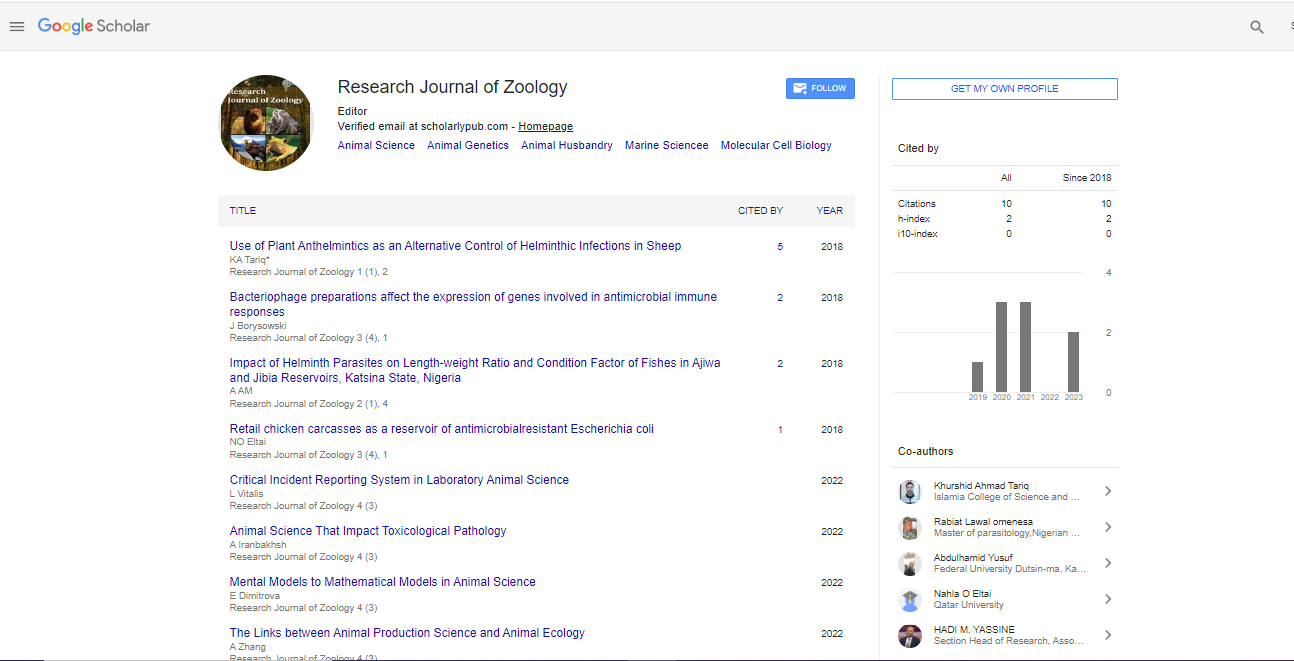Perspective, Res J Zool Vol: 5 Issue: 4
Challenges and Advances in Paleozoology and its Applications
Wolny Daniel*
1Department of Zoology, The University of British Columbia, Vancouver, Canada
*Corresponding Author: Wolny Daniel,
Department of Zoology, The University of
British Columbia, Vancouver, Canada
E-mail: daniel.wo@gmail.com
Received date: 21 November, 2023, Manuscript No. RJZ-24-128146;
Editor assigned date: 23 November, 2023, PreQC No. RJZ-24-128146 (PQ);
Reviewed date: 07 December, 2023, QC No. RJZ-24-128146;
Revised date: 15 December, 2023, Manuscript No. RJZ-24-128146 (R);
Published date: 22 December, 2023, DOI: 10.4172/RJZ.1000093.
Citation: Daniel W (2023) Challenges and Advances in Paleozoology and its Applications. Res J Zool 5:4.
Description
Paleozoology, a captivating field within the broader world of paleontology, provides a unique window into the ancient past by examining the fossilized remains of animals that once roamed the Earth. It delves into the evolutionary history, biodiversity, and ecological interactions of prehistoric creatures. Paleozoology, as the study of ancient animals, involves the analysis of animal fossils to reconstruct past ecosystems, trace evolutionary lineages, and gain insights into the behavior and anatomy of extinct organisms. The field depends on several scientific areas, including paleontology, geology, biology, and comparative anatomy of Earth's ancient fauna.
Fossils serve as the primary evidence in Paleozoology, providing direct remnants of past life preserved in sedimentary rocks. These fossils can range from bones and teeth to shells, footprints, and even imprints of soft tissues. The study of fossilized animal remains requires meticulous excavation, careful documentation, and frequently involves the use of advanced imaging and analytical techniques to glean information from preserved structures.
Stratigraphy, the study of rock layers and their chronological order, plays an essential role in Paleozoology. By correlating fossils with specific rock formations and dating techniques such as radiometric dating, paleozoologists construct timelines of past life, allowing them to infer the relative ages of different organisms and understand the patterns of biodiversity across geologic time.
Applications in anthropology and human evolution
Paleozoology extends its reach into the world of anthropology by contributing to the understanding of human evolution. The study of fossil primates and hominins, the evolutionary relatives, provides significant information about the evolutionary processes that shaped the emergence of Homo sapiens. Fossil evidence from Paleozoology helps to reconstruct the environments in which early hominins lived, the tools they used, and the adaptations that led to bipedalism and increased brain size. The discovery of hominin fossils, such as Ardipithecus and Australopithecus, contributes to the understanding of the evolutionary pathways that led to the development of modern humans.
Challenges and advances in paleozoology
While Paleozoology has produced novel insights, it is not despite difficulties. Fossilization is a rare process, and many organisms do not leave behind fossilized remains. Additionally, the geological processes of weathering, erosion, and tectonic activity can alter or destroy fossils over time. However, Advances in technology have transformed the field. High-resolution imaging techniques, such as Computed Tomography (CT) scans and synchrotron imaging, allow researchers to examine fossils without damaging them. Isotopic analysis provides information about the diets and environments of ancient organisms and molecular techniques provides indications into the genetic relationships among extinct organisms. The integration of paleontological data with data from other disciplines, such as geology, chemistry, and climatology, enhances the multidisciplinary nature of Paleozoology. Collaborative research efforts contribute to a more comprehensive understanding of Earth's history and the factors that shaped its biodiversity.
Ecological insights from paleozoology
Beyond evolutionary history, Paleozoology sheds light on past ecosystems, biodiversity patterns, and ecological interactions. Fossil assemblages from different time periods and environments provides information of the animals that evolved and the dynamics of their interactions. For instance, predator-prey relationships can be inferred from fossil evidence; Examples include the teeth imprints on bones and the preservation of incomplete material within the stomach contents of fossilised carnivores. Studying the dietary preferences and ecological roles of extinct organisms enhances the understanding of ancient food webs and ecosystem dynamics. Paleozoology also contributes to understanding of paleobiogeography-the distribution of organisms in space and time. By examining the fossils of similar organisms found in different regions, paleozoologists can infer past continental configurations, migration patterns, and the impact of changing climates on the distribution of life.
 Spanish
Spanish  Chinese
Chinese  Russian
Russian  German
German  French
French  Japanese
Japanese  Portuguese
Portuguese  Hindi
Hindi 
